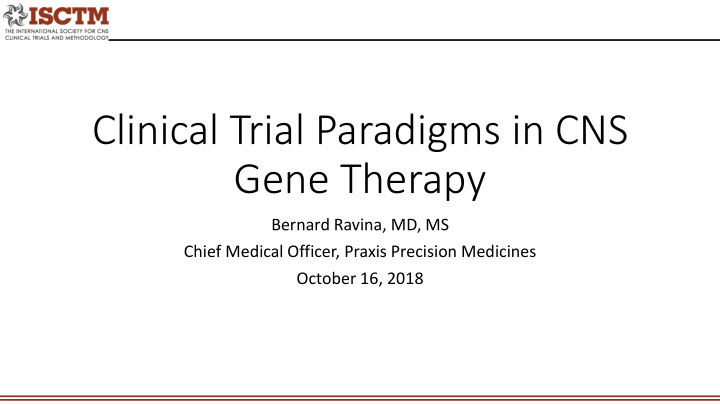



Clinical Trial Paradigms in CNS Gene Therapy Bernard Ravina, MD, MS Chief Medical Officer, Praxis Precision Medicines October 16, 2018
Disclosures • Employee, Praxis Medicines • Advisor, Voyager Therapeutics • Consultant, Cadent Therapeutics • Adjunct Professor of Neurology, University of Rochester • BOD/SAB member • Michael J Fox Foundation • Friedreich Ataxia Research Alliance • Hereditary Disease Foundation
Topics Key development questions • Who is CNS gene therapy for? • How is it delivered? • What is the development paradigm? • How are dose and safety assessed? • How is efficacy assessed? • How do we weight the evidence? • Clinical equipoise • Implications for use of controls
Who is CNS AAV Gene Therapy For? CNS Gene Therapy Targets Criteria for Selecting Gene Therapy Targets • High unmet need • Strong target validation • Appropriate therapeutic index • Ability to deliver to target • Direct delivery • Systemic delivery • Understanding of clinical measurement and ability to conduct informative trials
Delivery: local and systemic Systemic delivery in mouse Local Brain Delivery AAV9 – GFP, 1 x 10 12 AAV-PHP.B – GFP, 1 x 10 12 Waldy, 2012 Deverman, 2016
Clinical Trial Paradigms Traditional Drug/Biologic Approach Gene Therapy Approach 1. FIH - dose escalation trial(s) • In patients, never HVs • Limited dose range • Avoid subtherapeutic doses and toxicity • Delivery and safety main focus • No controls? • Efficacy is key secondary. Duration of effect may substitute for Phase 2 • No MAD • Repetition of trials typically due to changes in vector or delivery • Emphasis on clinical vs statistical inference 2. Single Efficacy Trial • Phase 2 aims typically subsumed in FIH and endpoints are well developed • Single efficacy trial often sufficient • Limited N, assumption of large effect • Importance of natural history Federal Register / Vol. 62, No.242 /1997
Successive Dose Finding Trials: Evolution of Brain Delivery MRI Guided Delivery • Standard Stereotactic Delivery Real time visualizations • Larger volumes • Minimize off target • 10x coverage of target • Inability to visualize infusion during surgery • Limited volume and coverage (<10%) • Visualized Valles et al, 2010
Ongoing Example of Two Stage Development: type 1 SMA Mendell, NEJM, 2017
Example of Two Stage Development: LCA2 Efficacy: Single RCT, Masked, Bilateral Delivery Dose Finding: Open Label, Unilateral Delivery Russell, Lancet.2017 Testa, Opthalmology.2013
Why a single efficacy trial may be sufficient • Prior probability of success, causal role of gene • Rare patient population limits feasible scope of trials and ability to conduct multiple trials • More uniform natural history/lack of standard of care treatments allows for causal inference • Risks and tolerance of gene therapy placebo delivery (sham surgery) • Benefit/risk • Limited other treatments in many cases • Potential for large treatment effects • Properties of the vector and unexpected safety (off target risk)
Clinical equipoise in the era of gene therapy • Clinical equipoise – socially, normatively defined • Concept articulated in response to a “crisis” in the ethical justification of control groups (Freedman, 1987) • Prior to Freedman, this uncertainty was viewed as operating at the individual investigator level • Clinical equipoise underscores the point that comparative trials operate in an ethical window before sufficient evidence to persuade investigators, regulators, and the professional community that a given investigational agent is superior to another option(s)
Implications for use of controls in gene therapy • Uncertainty is greatest early in development • The opportunity to efficiently use placebo comparators is unique to durable interventions like gene therapy • Initial participants could contribute to assessment of efficacy • If a randomized comparator is appropriate, this should be used as soon as there is a stable delivery paradigm • Waiting until later jeopardizes the conduct of high quality trials • Gene therapy clinical trials should be designed to efficiently determine when there is sufficient data to disrupt clinical equipoise rather than waiting until late in development to determine if there is still sufficient equipoise to support a high quality clinical trial.
Conclusions: Clinical Trial Paradigms in CNS Gene Therapy • Who is CNS gene therapy for? • How is it delivered? • What is the development paradigm? • How are dose and safety assessed? • How is efficacy assessed? • How do we weight benefit/risk • Clinical equipoise • Implications for use of controls
Recommend
More recommend